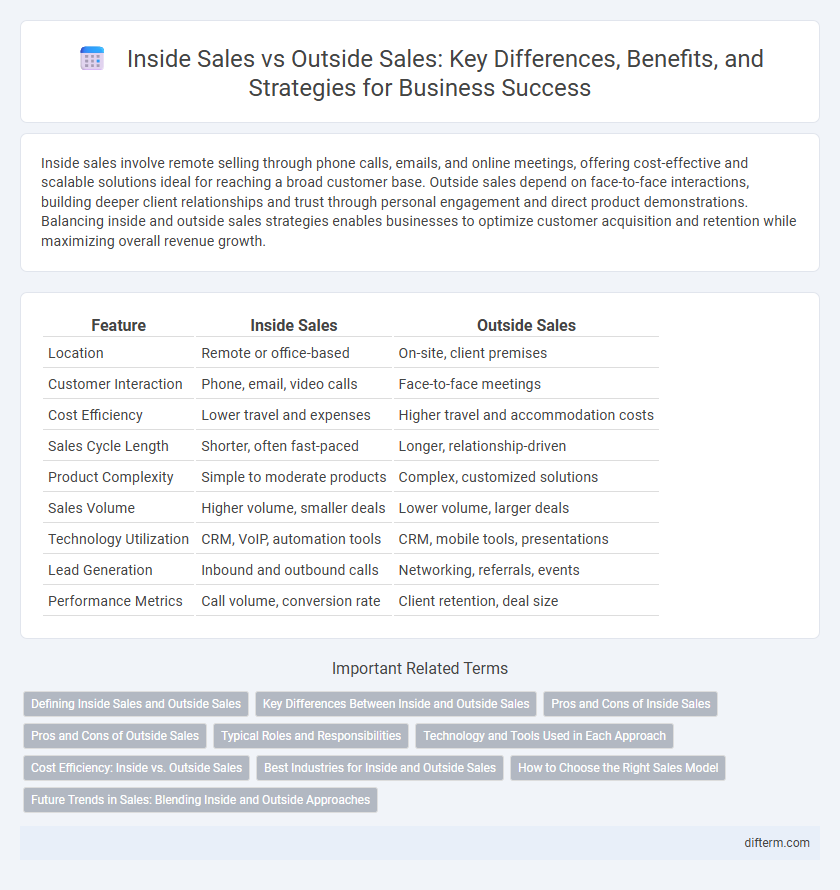Inside sales involve remote selling through phone calls, emails, and online meetings, offering cost-effective and scalable solutions ideal for reaching a broad customer base. Outside sales depend on face-to-face interactions, building deeper client relationships and trust through personal engagement and direct product demonstrations. Balancing inside and outside sales strategies enables businesses to optimize customer acquisition and retention while maximizing overall revenue growth.
Table of Comparison
| Feature | Inside Sales | Outside Sales |
|---|---|---|
| Location | Remote or office-based | On-site, client premises |
| Customer Interaction | Phone, email, video calls | Face-to-face meetings |
| Cost Efficiency | Lower travel and expenses | Higher travel and accommodation costs |
| Sales Cycle Length | Shorter, often fast-paced | Longer, relationship-driven |
| Product Complexity | Simple to moderate products | Complex, customized solutions |
| Sales Volume | Higher volume, smaller deals | Lower volume, larger deals |
| Technology Utilization | CRM, VoIP, automation tools | CRM, mobile tools, presentations |
| Lead Generation | Inbound and outbound calls | Networking, referrals, events |
| Performance Metrics | Call volume, conversion rate | Client retention, deal size |
Defining Inside Sales and Outside Sales
Inside sales involve remote selling activities conducted primarily through phone calls, emails, and digital communication tools, allowing sales representatives to engage and close deals without face-to-face interaction. Outside sales require direct, in-person meetings with clients at their location or industry events, emphasizing relationship-building and on-site presentations. Both methods leverage distinct strategies and tools tailored to target customer preferences and market dynamics in the business environment.
Key Differences Between Inside and Outside Sales
Inside sales rely predominantly on digital communication tools such as phone calls, emails, and video conferencing to engage prospects remotely, enabling cost-efficient and scalable outreach. Outside sales involve face-to-face interactions, allowing for personalized relationship-building and in-depth product demonstrations but typically incur higher travel and time costs. Key performance metrics for inside sales include call volume and conversion rates, whereas outside sales focus on territory management and client retention.
Pros and Cons of Inside Sales
Inside sales offers cost efficiency and scalability by leveraging digital communication tools to engage customers remotely, reducing travel expenses and enabling quicker response times. It allows for detailed tracking of customer interactions through CRM systems, facilitating data-driven decision-making and personalized sales approaches. However, inside sales may face limitations in building deep personal relationships and understanding complex customer needs compared to face-to-face interactions typical of outside sales.
Pros and Cons of Outside Sales
Outside sales offers direct client interaction and the opportunity to build strong, personalized relationships, often leading to higher-value deals and increased customer loyalty. However, it involves higher travel costs, time consumption, and can be less efficient compared to inside sales due to face-to-face meetings and logistical challenges. The effectiveness of outside sales depends on industries requiring complex negotiations and on-site demonstrations, while it may be less suitable for high-volume, low-margin transactions.
Typical Roles and Responsibilities
Inside sales representatives primarily handle lead generation, customer outreach via phone or email, and manage sales pipelines using CRM tools to close deals remotely. Outside sales professionals focus on face-to-face client meetings, relationship building, and territory management, often attending trade shows and networking events to drive new business. Both roles require strong communication skills, product knowledge, and sales strategy execution but differ significantly in their approach to customer engagement and sales environments.
Technology and Tools Used in Each Approach
Inside sales teams rely heavily on CRM software, video conferencing tools, and email automation platforms to manage leads and foster client relationships remotely. Outside sales professionals utilize mobile devices, GPS tracking, and field service management apps to optimize face-to-face customer interactions and territory management. Both approaches leverage data analytics and sales enablement technologies to enhance productivity and close deals efficiently.
Cost Efficiency: Inside vs. Outside Sales
Inside sales generally offer greater cost efficiency by utilizing digital tools and remote communication, reducing travel and accommodation expenses inherent in outside sales. Outside sales incur higher operational costs due to in-person meetings, transportation, and extended client visits, impacting overall profitability. Businesses prioritizing budget optimization often favor inside sales for scalable outreach and streamlined expense management.
Best Industries for Inside and Outside Sales
Inside sales excel in industries like technology, software, and SaaS where remote demos and quick follow-ups drive high-volume transactions. Outside sales are most effective in sectors such as manufacturing, construction, and pharmaceuticals, where face-to-face meetings and relationship-building with clients are crucial. Targeting inside sales for fast-paced, digital-ready markets and outside sales for complex, high-value deals optimizes revenue and customer engagement.
How to Choose the Right Sales Model
Choosing the right sales model depends on your target market, product complexity, and customer relationship needs. Inside sales leverages technology for remote communication and is ideal for cost-efficiency and high-volume transactions, while outside sales emphasizes face-to-face interactions for building trust and handling complex negotiations. Analyze factors like customer location, sales cycle length, and budget constraints to determine whether inside, outside, or a hybrid sales approach best aligns with your business objectives.
Future Trends in Sales: Blending Inside and Outside Approaches
Future trends in sales emphasize integrating inside and outside sales strategies to maximize customer engagement and efficiency. Leveraging digital tools, inside sales teams provide data-driven insights and personalized communication, while outside sales focus on building deep, relationship-based trust through face-to-face interactions. This hybrid approach enhances sales performance by combining scalability with authentic client connections, driving revenue growth in competitive markets.
inside sales vs outside sales Infographic

 difterm.com
difterm.com